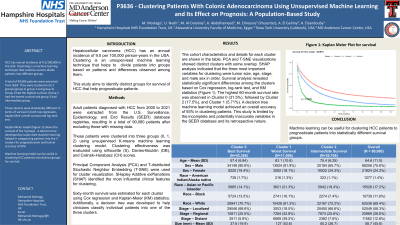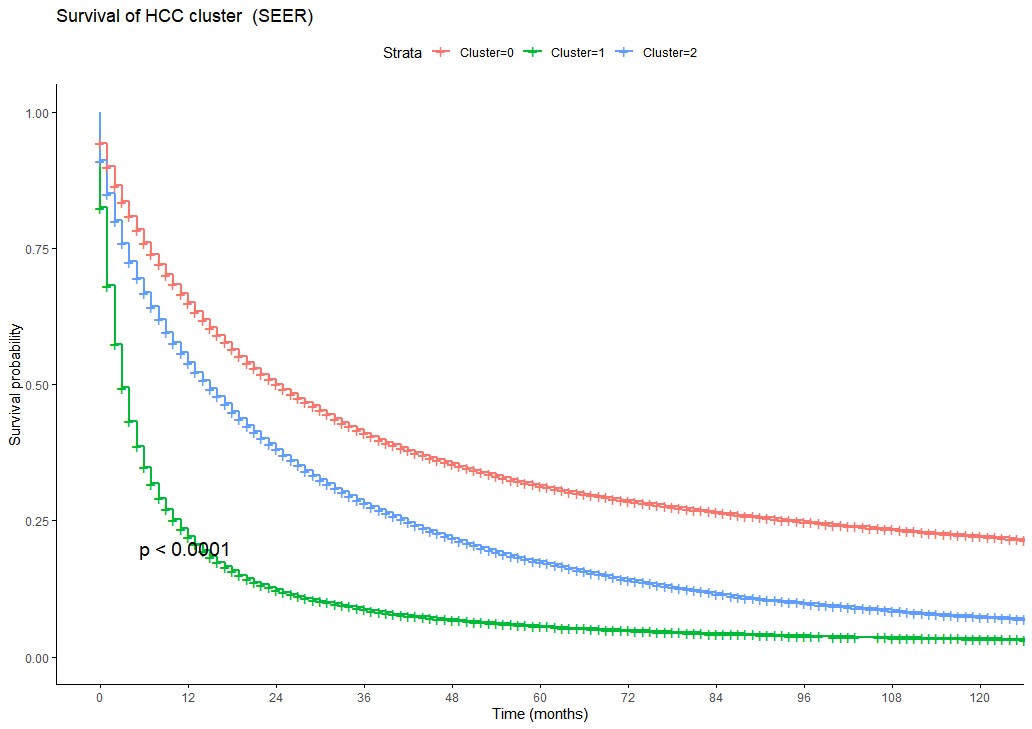Tuesday Poster Session
Category: Liver
P4574 - Clustering Hepatocellular Carcinoma Patients Using Unsupervised Machine Learning and Its Effect on Survival: A Population-Based Study
Tuesday, October 29, 2024
10:30 AM - 4:00 PM ET
Location: Exhibit Hall E

Has Audio
- ME
Marawan Elmassry, MBBCh
Texas Tech University Health Sciences Center
Lubbock, TX
Presenting Author(s)
Mohamed Mortagy, MBBCh1, Umed Nadir, MBBS1, Muhammad Al-Dulaimy, MBBS1, Aya Abdelhameed, MBBCh2, Marawan Elmassry, MBBCh3, Amr Elgehiny, MBBCh4, Ahmed Elsandouby, MBBCh1
1Hampshire Hospitals NHS Foundation Trust, Winchester, England, United Kingdom; 2Alexandria University, Alexandria, Al Iskandariyah, Egypt; 3Texas Tech University Health Sciences Center, Lubbock, TX; 4MD Anderson Cancer Center, Houston, TX
Introduction: Hepatocellular carcinoma (HCC) has an annual incidence of 9.5 per 100,000 person-years in the USA. Clustering is an unsupervised machine learning technique that helps subgroup patients based on patterns and differences observed among them.
Methods: A total of 90,080 adult patients diagnosed with HCC from 2000 to 2021 were extracted from the U.S. Surveillance, Epidemiology, and End Results (SEER) database after excluding patients with missing data. These patients were clustered into three groups (0, 1, 2) using unsupervised machine learning with K-means clustering. Clustering effectiveness was evaluated using silhouette (S), Davies-Bouldin (DB), and Calinski-Harabasz (CH) scores. Principal Component Analysis (PCA) and T-distributed Stochastic Neighbor Embedding (T-SNE) were used for cluster visualization. SHapley Additive exPlanations (SHAP) identified the most influential clinical features for clustering. Sixty-month survival was estimated for each cluster using Cox regression and Kaplan-Meier (KM) statistics. The impact of chemotherapy, radiotherapy, and surgery on each cluster survival was visualized with Kaplan-Meier curves. A decision tree was generated using supervised machine learning to classify patients into one of the three clusters.
Results: The cohort characteristics and details for each cluster are shown in Table 1. T-SNE and PCA visualizations showed good clustering . SHAP analysis indicated that the four most important variables for clustering were tumor size, age, stage, and sex in order. Survival analysis revealed statistically significant differences among the clusters based on Cox regression, log-rank test, and KM statistics (Figure 1). The highest 60-month survival rate was observed in Cluster 0 (31.5%), followed by Cluster 2 (17.5%), and Cluster 1 (5.71%). The decision tree achieved an overall accuracy of 92% in clustering patients. Patients receiving surgery, chemotherapy, or radiotherapy demonstrated improved survival across all clusters. This study is limited by some incomplete and potentially inaccurate variables in the SEER database and its retrospective nature.
Discussion: Unsupervised machine learning could be useful for clustering HCC patients. This could help identify new subgroups or interactions between variables to be able to predict survival outcomes, and assess treatment effects within different patient clusters.

Note: The table for this abstract can be viewed in the ePoster Gallery section of the ACG 2024 ePoster Site or in The American Journal of Gastroenterology's abstract supplement issue, both of which will be available starting October 27, 2024.
Disclosures:
Mohamed Mortagy, MBBCh1, Umed Nadir, MBBS1, Muhammad Al-Dulaimy, MBBS1, Aya Abdelhameed, MBBCh2, Marawan Elmassry, MBBCh3, Amr Elgehiny, MBBCh4, Ahmed Elsandouby, MBBCh1. P4574 - Clustering Hepatocellular Carcinoma Patients Using Unsupervised Machine Learning and Its Effect on Survival: A Population-Based Study, ACG 2024 Annual Scientific Meeting Abstracts. Philadelphia, PA: American College of Gastroenterology.
1Hampshire Hospitals NHS Foundation Trust, Winchester, England, United Kingdom; 2Alexandria University, Alexandria, Al Iskandariyah, Egypt; 3Texas Tech University Health Sciences Center, Lubbock, TX; 4MD Anderson Cancer Center, Houston, TX
Introduction: Hepatocellular carcinoma (HCC) has an annual incidence of 9.5 per 100,000 person-years in the USA. Clustering is an unsupervised machine learning technique that helps subgroup patients based on patterns and differences observed among them.
Methods: A total of 90,080 adult patients diagnosed with HCC from 2000 to 2021 were extracted from the U.S. Surveillance, Epidemiology, and End Results (SEER) database after excluding patients with missing data. These patients were clustered into three groups (0, 1, 2) using unsupervised machine learning with K-means clustering. Clustering effectiveness was evaluated using silhouette (S), Davies-Bouldin (DB), and Calinski-Harabasz (CH) scores. Principal Component Analysis (PCA) and T-distributed Stochastic Neighbor Embedding (T-SNE) were used for cluster visualization. SHapley Additive exPlanations (SHAP) identified the most influential clinical features for clustering. Sixty-month survival was estimated for each cluster using Cox regression and Kaplan-Meier (KM) statistics. The impact of chemotherapy, radiotherapy, and surgery on each cluster survival was visualized with Kaplan-Meier curves. A decision tree was generated using supervised machine learning to classify patients into one of the three clusters.
Results: The cohort characteristics and details for each cluster are shown in Table 1. T-SNE and PCA visualizations showed good clustering . SHAP analysis indicated that the four most important variables for clustering were tumor size, age, stage, and sex in order. Survival analysis revealed statistically significant differences among the clusters based on Cox regression, log-rank test, and KM statistics (Figure 1). The highest 60-month survival rate was observed in Cluster 0 (31.5%), followed by Cluster 2 (17.5%), and Cluster 1 (5.71%). The decision tree achieved an overall accuracy of 92% in clustering patients. Patients receiving surgery, chemotherapy, or radiotherapy demonstrated improved survival across all clusters. This study is limited by some incomplete and potentially inaccurate variables in the SEER database and its retrospective nature.
Discussion: Unsupervised machine learning could be useful for clustering HCC patients. This could help identify new subgroups or interactions between variables to be able to predict survival outcomes, and assess treatment effects within different patient clusters.

Figure: Figure 1: Kaplan Meier Graph Showing the Survival of the 3 Hepatocellular Carcinoma Clusters generated using unsupervised machine learning
Note: The table for this abstract can be viewed in the ePoster Gallery section of the ACG 2024 ePoster Site or in The American Journal of Gastroenterology's abstract supplement issue, both of which will be available starting October 27, 2024.
Disclosures:
Mohamed Mortagy indicated no relevant financial relationships.
Umed Nadir indicated no relevant financial relationships.
Muhammad Al-Dulaimy indicated no relevant financial relationships.
Aya Abdelhameed indicated no relevant financial relationships.
Marawan Elmassry indicated no relevant financial relationships.
Amr Elgehiny indicated no relevant financial relationships.
Ahmed Elsandouby indicated no relevant financial relationships.
Mohamed Mortagy, MBBCh1, Umed Nadir, MBBS1, Muhammad Al-Dulaimy, MBBS1, Aya Abdelhameed, MBBCh2, Marawan Elmassry, MBBCh3, Amr Elgehiny, MBBCh4, Ahmed Elsandouby, MBBCh1. P4574 - Clustering Hepatocellular Carcinoma Patients Using Unsupervised Machine Learning and Its Effect on Survival: A Population-Based Study, ACG 2024 Annual Scientific Meeting Abstracts. Philadelphia, PA: American College of Gastroenterology.
